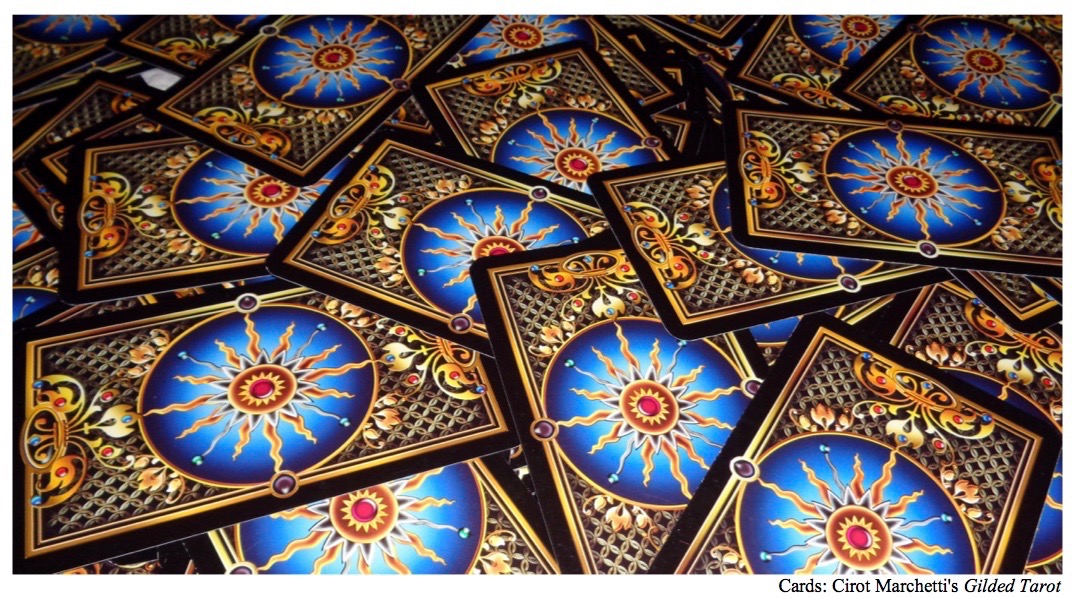By Wayne Limberger
Recently I've been involved in a seemingly endless online debate over how to shuffle a tarot deck to get the best result. Overhand shuffling, riffle shuffling, faro shuffling, and simply mixing the cards face-down on a table top all have their proponents, along with unique approaches to dealing the deck into several piles and then randomly reassembling it. What gets much less attention is why we shuffle in the first place, beyond the fact that beginner's books tell us to do so. The obvious assumption is that we're trying to disperse the cards in a random way that forestalls getting a predictable set or series of related cards when laying out the spread, as often happens when using a new deck or doing back-to-back readings with a single deck. A more realistic viewpoint is that the ultimate purpose of the shuffle isn't to introduce absolute diversity, but rather to subjectively rearrange the cards in a manner that generates one particular storyline and no other.
A parallel discussion addresses whether the deck should be put back in its original order after every reading, thus purging it of any residual energy from the previous use. The shuffler then faces the daunting task of reinstating a salutary degree of disorder preliminary to linking the chosen cards for the spread. Again, the tarot house is divided on this; those who believe the cards can hold onto a client's psychic energy will do it as a "cleansing" step, while those who don’t could not care less about refreshing the deck in this way. This concern strikes me as more a fanciful notion than a practical one – after all, tarot cards are a symbolic tool made of ink and paper, not a repository for subtle mental emanations that can't really be captured and retained in an inanimate object unless one intentionally "charges" it for a specific purpose. The magic lies in the dynamic intersection of the querent, cards, and reader that changes from reading to reading, not in any single, discrete factor. Personally, I consider the most effective scenario to be starting with a truly random distribution of cards that then converge on a select sequence as the shuffle progresses. I should also note that I expect my clients to shuffle and cut the cards since it's their subconscious understanding of the situation I want to be invested in the final alignment, not mine.
I
always thoroughly randomize my decks before reading in a professional
setting and, since there often isn't time between readings to do that
with a single deck, I take a few randomized decks with me to a
reading session. I randomize both for sequence and for orientation.
The main problem with routinely reordering the cards according to
their “out-of-the-box” rank, suit and number series is that my
sitters seldom shuffle long enough and well enough to achieve a
distribution that accurately zeros in on their private reality, so
the cards "clump" in arrays that I find difficult to take
seriously. Whenever I see something like the Ace, Two, Three and Four
of the same suit appearing sequentially in a spread, I'm immediately
suspicious that the deck did not receive sufficient randomizing.
My
preferred method for drawing cards can be vulnerable to this
weakness, so I use the "deal randomly into several piles"
technique to separate any existing clumps before departing for a
session. My clients then do their part by reorganizing the deck in
just the right way to deliver the message. If I do have downtime in
the middle of the client cycle, I'll spare a few minutes to do it
again, since it takes no more time to deal 78 cards into several
piles than it does to thoroughly shuffle them. When you think about
it, the sitters' objective in shuffling the deck is to align the
cards subconsciously in the proper order for the reading, so I prefer
them to start with a "random scatter" that eventually
coalesces into a meaningful pattern as they shuffle. This approaches
the goal from the opposite end of the spectrum, drawing sympathetic
cards together out of a featureless "cloud" rather than
trying to induce intelligible distinctions within a prescribed order
by shuffling to disrupt that order.
One way to dodge the clumping
phenomenon is to draw the cards randomly from a fanned array (which
can be done with a minimal shuffling of any kind), but I find that
cumbersome and counter-intuitive to the purpose of the client's
shuffle. While it may force randomness on the selection process, it
somehow doesn't feel quite right – more arbitrarily mechanical than
fluid and seamless in its execution.
There is no "right" way to shuffle the cards, just as there is no "right" way to read them. There are (or should be) good reasons for doing what we do, and the considerations I've mentioned might profitably be kept in mind when deciding how to proceed. Like many things about the tarot, this is an area where only personal experience will tell you what works best in your own practice.
